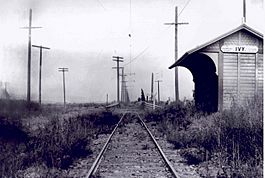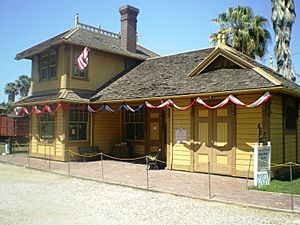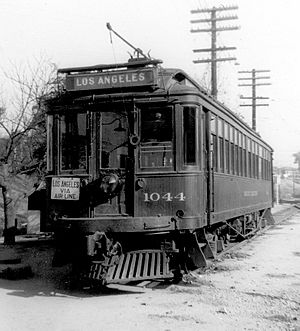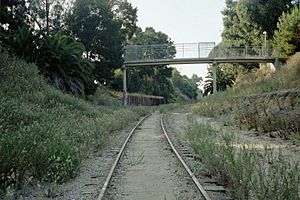Santa Monica Air Line facts for kids
Quick facts for kids Santa Monica Air Line |
|
|---|---|
 |
|

The Air Line looking west from Ivy station (later Culver Junction), with the junction and station building in the foreground, 1905
|
|
| Overview | |
| Owner | Southern Pacific Railroad |
| Locale | Los Angeles |
| Termini | Pacific Electric Building Santa Monica, California |
| Stations | 15 |
| Service | |
| Type | Interurban |
| System | Pacific Electric |
| Operator(s) | Pacific Electric |
| History | |
| Opened | July 1908 |
| Closed | October 26, 1953 |
| Technical | |
| Line length | 16.88 mi (27.17 km) |
| Track gauge | 1,435 mm (4 ft 8 1⁄2 in) standard gauge |
| Electrification | 600 V DC Overhead lines |
The Santa Monica Air Line was an important electric train route in Los Angeles. It connected Santa Monica to downtown Los Angeles. This train line was used for passengers from 1908 to 1953.
After it stopped carrying passengers, much of the route was turned into a modern light rail line. Today, it is part of the Metro E Line.
Contents
Exploring the Air Line Route
The Santa Monica Air Line traveled across Los Angeles, connecting many neighborhoods. It was a key way for people to get around.
From Downtown Los Angeles to Culver Junction
The journey began at the Pacific Electric Building in downtown Los Angeles. The train crossed Los Angeles Street on a special bridge. It then turned onto San Pedro Street, heading south.
The line continued, turning onto Ninth Street. It followed a special path just for the train. Near 25th Street and Long Beach Boulevard, the Air Line left the main Watts route. It then went west, cutting across the city until it reached Flower Street.
From there, it joined Exposition Boulevard. At the end of Exposition, the route followed Jefferson Boulevard to La Cienega. It then generally followed Washington and National Boulevards. This path led all the way to a spot called Culver Junction.
From Culver Junction to Santa Monica
From Culver Junction, the route turned north. It crossed Overland Avenue. The train continued on its own path between Exposition and Olympic Boulevards.
Eventually, it reached Colorado Boulevard. The line then ran next to Colorado Boulevard all the way to Santa Monica. Near Main Street, the line curved to meet Pico Boulevard. The journey ended south of Main and Hollister, at the Ocean Park car house.
Main Stops Along the Way
Here are some of the main stops on the Santa Monica Air Line in 1911. Major stations are shown in bold.

| Station | Mile |
|---|---|
| Los Angeles | 0.00 |
| Nevin | 2.62 |
| Hooper | 3.05 |
| San Pedro Street | 3.77 |
| Jefferson | 4.18 |
| Grand Avenue | 4.54 |
| University | 5.40 |
| 11th Avenue | 7.68 |
| Sentous | 10.04 |
| Culver Junction (Venice Blvd and Culver Blvd) |
11.16 |
| The Palms | 12.20 |
| Talamantes | 13.73 |
| Home Junction | 14.87 |
| Soldiers' Home | 15.87 |
| Bergamot | 15.25 |
| Sunset | 16.18 |
| Santa Monica | 16.88 |
| Tool House | 17.54 |
| Ocean Park | 19.20 |
How the Air Line Worked
The trains on the Air Line were electric. They got their power from the Ivy Substation. This substation supplied 600 volts of direct current (DC) electricity. Later, after passenger service ended, the trains switched to diesel engines.
History of the Air Line
The Santa Monica Air Line has a long history. It started out as a steam-powered railroad.
Early Beginnings and Electric Trains
The line was first built in 1875. It was called the Los Angeles and Independence Railroad. Its main purpose was to carry mined ore to ships at Santa Monica harbor's Long Wharf. It also offered fun passenger trips to the beach.
Later, the Southern Pacific Railroad bought the line. They then leased it to the Los Angeles Pacific Railroad. This company used it for electric passenger trains and light freight.
Electric power lines were installed on the route in May 1908. Electric train service began that July. The Pacific Electric company bought the line in 1911. This included all the other lines owned by Los Angeles Pacific.
In 1912, the tracks between Culver Junction and Amoco Junction were electrified. This allowed trains to reach downtown Los Angeles using the Watts Line. The Long Wharf in Santa Monica harbor closed to ships in 1913.
Decline and End of Passenger Service
Over time, fewer people lived along parts of the Air Line route. Because of this, train service was reduced as early as 1924. Passenger trains only ran during busy rush hours. Most people traveling to Santa Monica used a different train line by then.
By 1931, the Pacific Electric company ran only one round-trip train each day. The railroad tried to stop the service completely in 1933. However, people who used the line fought to keep it open.
The company even stopped printing regular schedules for the Air Line. They hoped this would make fewer people ride the train. But fans of the service would advertise the trips themselves.
Passenger service on the Air Line finally stopped on October 26, 1953. In its last few weeks, only one daily round trip ran. This marked the end of all passenger services for the Pacific Electric railroad.
Freight Trains and Abandonment
Even after passenger service ended, freight trains continued to use the tracks. The Air Line route was connected to another line on Sepulveda Boulevard. This made it the only way for freight trains to reach warehouses in West Los Angeles, Beverly Hills, and Hollywood. These trains usually ran at night due to city rules.
Over the years, less freight was moved by train. The tracks along Santa Monica and Sepulveda boulevards were removed. Train service became very rare. The tracks near Exposition Park were sometimes used for special purposes. They held circus trains in the 1980s. They also stored passenger cars during the 1984 Olympic Games.
The very last freight train ran from Fisher Lumber in Santa Monica on March 11, 1988. After that, the line was no longer used for trains.
The Southern Pacific company still owned the land. They leased parts of it for buildings. By the mid-1990s, parking lots, storage places, and shops covered most of the old tracks. Only old signal cantilevers and crossing gates showed that a train line had once been there. East of Sepulveda Boulevard, the tracks, bridges, and tunnels remained but were overgrown.
An old boxcar was left on a side track. This track once served a warehouse at 10151 National Boulevard. In 2005, the building was torn down. The boxcar was cut apart and removed to make way for a new storage facility.
The Air Line's New Life
The old Air Line route was given a new purpose. It was bought by what is now Los Angeles Metro in 1990.

Work to replace the tracks and build new structures began in 2006. The first part of the "Expo Line" opened in April 2012. It connected downtown Los Angeles to Culver City. The second part, extending to Santa Monica, opened on May 20, 2016.
Most of the original Air Line structures were replaced. However, two important parts remain from the old days. The steel bridge over National Boulevard was strong enough to be reused. A new bridge was added next to it for a second track. Also, the tunnel under the Santa Monica Freeway was put back into use.
Soldiers' Home Branch Line
A smaller branch line connected to the Air Line. This branch ran for about 2.14 miles from Home Junction to the Sawtelle Veterans Home. It was also updated for electric service in 1908.
This branch became part of the new Pacific Electric system. It operated as a shuttle service, carrying people back and forth. This shuttle service ran until about July 1920.




